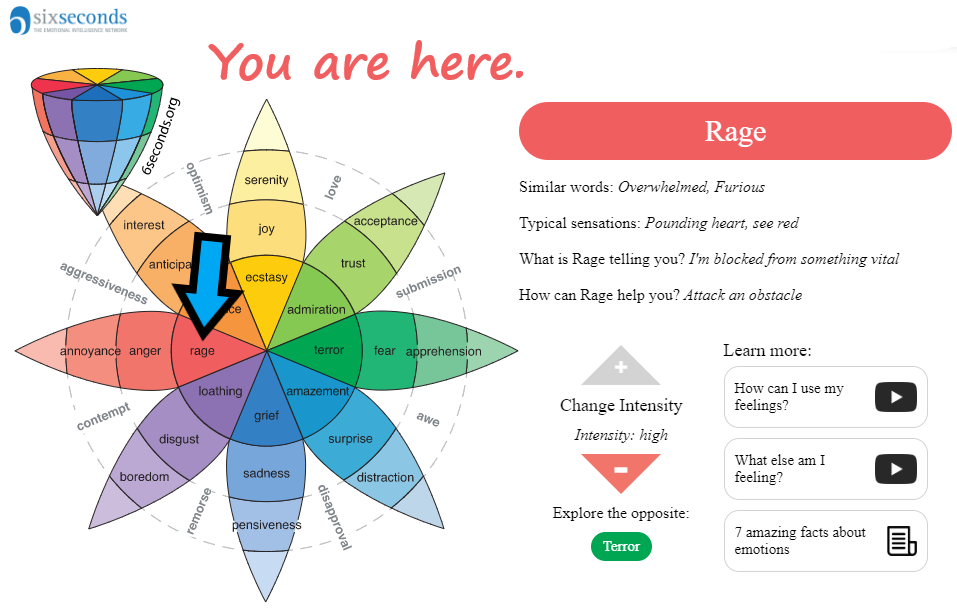
Rage.
Rage is an emotion that is bubbling up and erupting with increased frequency in US politics. Given its surging prevalence, I want to pause to explore this emotion – its what, how and why. Emotions are the filters through which we see the world. Do we want to see red?
The image for this post, modified from 6 Seconds website (link below), depicts the Plutchik Wheel of Emotions. Plutchik was a psychologist who framed emotions in terms of their intensity and evolutionary function. In his model, rage is one of 8 primary human emotions and the most intense form of anger. Anger is the emotion we feel when we are blocked from something important. Anger energizes us to break through barriers. When a barrier separates us from what we perceive to be of extreme, even life-or-death importance, we escalate to rage. The thinking centers of the brain shut down, the heart rate goes up, and the body floods with cortisol. The message: Tear down the barriers! I am ready to fight for my life!
When we look at the historical pattern, the go-to option for collective rage has been war against the out-group. This past precedent, however, is no longer a guide for our present dilemma. On a global scale, COVID, climate change and an interdependent world economy all point to the same fact – we as humans have a shared fate. Any “down-with-the-out-group” mentality will only hurt ourselves in the long run. Still, when rage comes up, the conditioned urge to create an out-group to hate seems irresistible and even unavoidable. Is there a type of rage that can push us forward instead of pulling us back?
Triggering situations and big emotions have much to teach us. They are an ordeal that changes us and we can experience them as a trauma or an initiation. Either way, we may walk away with scars. In my experience, the difference between rage that takes me forward and rage that takes me back is presence. Presence is about emotional awareness and emotional navigation. Am I powerfully responding to the here and now or am I unconsciously reacting according to past conditioning? Below are strategies I use when rage comes up for me. They are a mix of validation, exploration and transformation. Depending on where you are in any given moment, one of them may work better than others.
Let off steam in a safe container. This may mean physical activity or venting with someone I trust. Sometimes it can be screaming or hitting a pillow. It doesn’t have to be pretty or make sense.
Take stock of all the emotions. What else am I feeling? Is the loudest emotion in the room masking another emotion that I am afraid to feel? What am I releasing and what am I bottling up?
Examine causes and effects. Am I emotionally caught up or projecting past hurts into the present? What button is this external situation pressing on me internally? Am I caricaturing the person or catastrophizing the situation to justify my actions? What will be the likely consequences of my actions and is this what I really want? What does this situation look like from the standpoint of the other person? Would I rather be happy or right?
Reframe the relationship. In the natural world, predators and prey may seem like enemies. They seem locked in a mutually exclusive struggle to survive and the loss of one seems the gain of the other. Yet, if one species was able to become entirely dominant, it would briefly flourish and then crash. In nature, life-or-death struggle pushes both species to evolve. It prevents excess and promotes vitality. When values clash in the human world, I may at first think I want only others like me and no enemies. That arrangement, however, does not produce thriving.
Choose what you want. One of the most powerful paradigm shifts I’ve had around emotions is realizing that instead of circumstances driving my emotions I can choose the emotions that drive my circumstances. An action powered by rage I will experience in a certain way with a certain result. The same action powered by a different emotion I will experience differently and with a different result. The question then becomes – what experience and what results do I want? Or – what aspect of me does this situation call for?
The times we are living in are times of intense challenges. All periods of transition are. Emotional awareness and emotional navigation are vital skills to facing these challenges whether at the personal or societal level. Such skills and the above strategies don’t come all at once but can be learned and practiced – that is the work of emotional intelligence. If you like what you read about rage and are curious about other emotions, check out Plutchik’s Wheel. If you have other successful strategies in navigating rage, let me know!